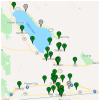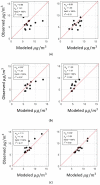Using Low-Cost Air Quality Sensor Networks to Improve the Spatial and Temporal Resolution of Concentration Maps
- PMID: 30965621
- PMCID: PMC6480232
- DOI: 10.3390/ijerph16071252
Using Low-Cost Air Quality Sensor Networks to Improve the Spatial and Temporal Resolution of Concentration Maps
Abstract
We present an approach to analyzing fine particulate matter (PM2.5) data from a network of "low cost air quality monitors" (LCAQM) to obtain a finely resolved concentration map. In the approach, based on a dispersion model, we first identify the probable locations of the sources, and then estimate the magnitudes of the emissions from these sources by fitting model estimates of concentrations to corresponding measurements. The emissions are then used to estimate concentrations on a grid covering the domain of interest. The residuals between model estimates at the monitor locations and the measured concentrations are then interpolated to the grid points using Kriging. We illustrate this approach by applying it to a network of 20 LCAQMs located in the Imperial Valley of Southern California. Estimating the underlying mean concentration field with a dispersion model provides a more realistic estimate of the spatial distribution of PM2.5 concentrations than that from the Kriging observations directly.
Keywords: Kriging; LCAQM; PM2.5; dispersion modeling; imperial valley; spatial interpolation.
Conflict of interest statement
The authors declare no conflict of interests.
Figures















References
-
- Hagler G.S.W., Solomon P.A., Hunt S.W. EM Air Waste Manag. Assoc. Mag. Environ. Manag. Air Waste Manag. Assoc.; Pittsburgh, PA, USA: 2014. New technology for low-cost, real-time air monitoring.
-
- Wang Y., Li J., Jing H., Zhang Q., Jiang J., Biswas P. Laboratory evaluation and calibration of three low-cost particle sensors for particulate matter measurement. Aerosol Sci. Technol. 2015;49:1063–1077. doi: 10.1080/02786826.2015.1100710. - DOI

